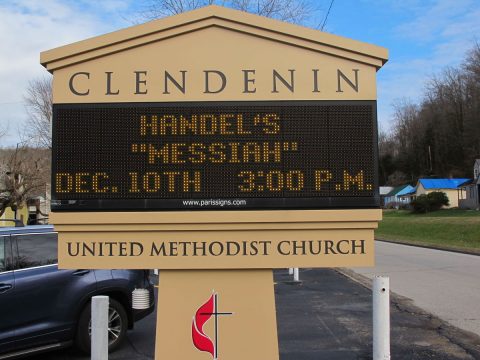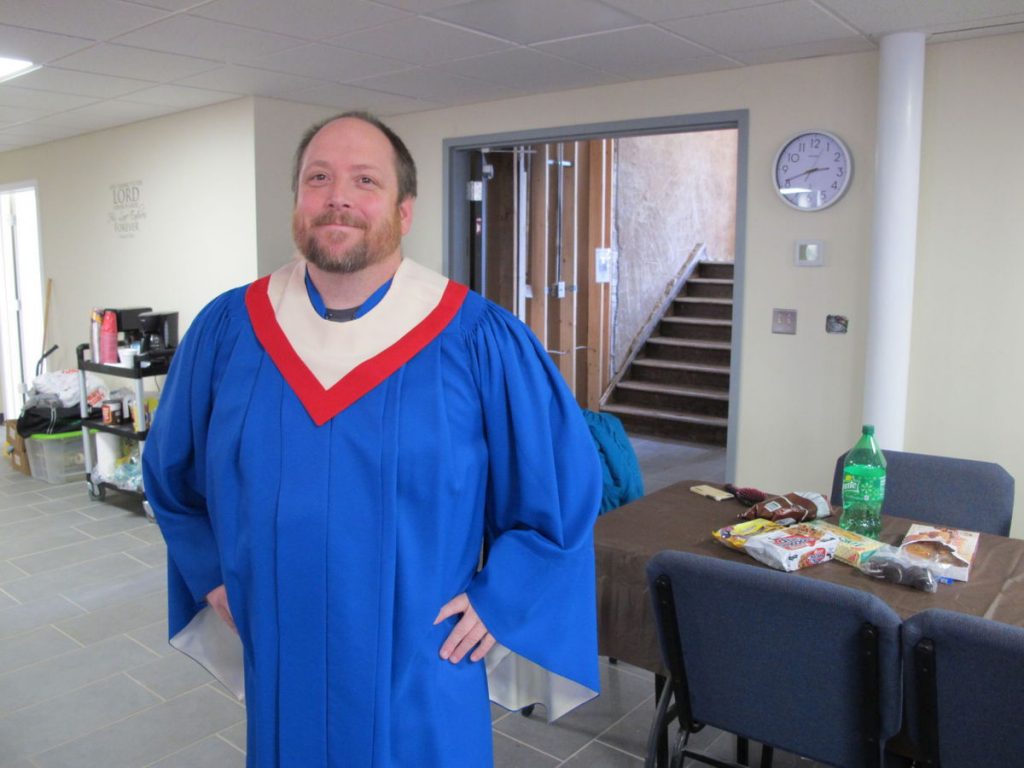Courtesy photo. With scant rehearsal time and a worn copy of the score to Handel’s “Messiah,” reporter Bill Lynch joined the Clendenin United Methodist community choir’s annual performance of the Christmas classic.
By: Bill Lynch, Entertainment Reporter | Posted: Dec. 21, 2017 | Source: WV Gazette-Mail
After six months of singing bass in a barbershop chorus, I’d become a little brave. When I heard Clendenin United Methodist Church held an annual community singing of Handel’s “Messiah,” I signed up.
I’ve never been accused of being overly religious. But it seemed important that if I was going to spend some time exploring Christmas, I needed to acknowledge the reason for the season, which is the celebration of the birth of Jesus Christ.
Arguments can be made that we’ve got the day and the month wrong, or that Christmas is an adaptation of old Pagan traditions, or that the current practice of Christmas has less and less to do with faith and more with commerce.
But that hardly matters.
At its heart, Christmas celebrates the key figure in Christianity, and Handel’s “Messiah” celebrates his birth, death and resurrection.
There were only two minor problems to work out.
First, I didn’t have the music, had never seen the score and believed the whole piece worked around singing “hallelujah” a whole bunch of times — like I did, probably, in public school.
Second, due to prior obligations, I could only make one of the three rehearsals.
The folks at the church said, “No problem.” My experience with the Kanawha Kordsmen was good enough.

Courtesy photo. The choir performs the piece annually at the church in Clendenin. This year, about 25 people joined the chorus for a small crowd of about 40.
‘It will be fine’
It was a very small group that gathered the afternoon I arrived at the Clendenin United Methodist Church. There were maybe 10 women and five men at the rehearsal, including H.G. Young, the director, who played piano.
Another pianist would later handle the music while he conducted.
“It will be fine,” he promised.
And then I got the book — the Schirmer edition.
Schirmer was G. Schirmer, a sheet-music publishing company that’s been around since 1861.
There were other editions, other companies that published the score. George Frideric Handel wrote “Messiah” in 1741. The music has been adapted, arranged and rearranged probably countless times.
H.G. said if I had another choral edition, it would probably be fine. Mostly, trouble would come from the way pages were numbered.
He didn’t want anyone to get lost. Then he handed me a copy to borrow.
With the Kanawha Kordsmen, most of our songs are just a couple of pages long. The longest one, I think, is an Armed Forces medley, where we sing the theme songs to every division of the military from the Coast Guard to the Air Force.
The score for Handel’s “Messiah” was considerable — about the size of a pie cookbook or an auto-repair manual for an old Chevette.
My copy had been loaned out many times and had seen better days. The cover was slipping off. Pages felt loose, and just looking at the thing, I had no idea what I was supposed to do with all of these notes.
“Don’t worry,” H.G. told me, cheerfully. “We’re not doing the whole thing, just a few sections. You’ll be fine.”
I promised nothing, but I took a seat in a pew with the other bass and tried to follow along as H.G. marched us through the music.
H.G told me, “Don’t worry about it. Just do your best.”
He promised it would all sound better when everyone else was here, and besides, he had a couple of ringers, soloists who would fill out the sound.
This was a community chorus. Several of the singers had come from the Civic Chorus or the West Virginia Symphony Chorus. But a few of us had less experience and had come to just keep a local tradition alive.
Nobody expected this to sound like the Mormon Tabernacle Choir playing the White House.
Church roots
The Methodist church in Clendenin was quietly impressive — solid wood pews and tall, stained-glass windows whose colors in the cold, gray light of December reminded me of abalone shell and mother of pearl.
In full sun, I imagined the windows glowed.
Behind the choir loft were the pewter-colored pipes of a pipe organ, and the sanctuary included a balcony.
I was fascinated to find such a place in sleepy, little Clendenin.
Of course, like a lot of places in West Virginia, Clendenin wasn’t so sleepy. It thrived in a modest, small-town-America way.
The roots of the Methodist congregation in Clendenin go back to before West Virginia was a state. The property where the church stands was first built around 1880, though it wasn’t the only Methodist church in town.
Prior to the Civil War, the Methodist church split, with the Methodist Episcopal Church, South forming in slave-owning states.
However, it wasn’t unusual for there to be more than one Methodist church in a particular town.
The site of Clendenin United Methodist Church belonged to the South, while another congregation, representing the Methodist Episcopal Church, held services in a church across the river.
After the war, the two churches remained separate.
I don’t know anything about the other Methodist church, but the Southern church continued to grow and built the current building in 1921.
In 1938, as other Methodist churches around the country decided it was long past time to unite and reconcile, the two Methodist Churches in Clendenin agreed to do the same.
“It was supposedly a really moving thing,” H.G. told me. “The other church met where they usually did, across the river, gathered, and then came across the bridge as a group.”
He said the two churches didn’t actually unite under one roof until 1939, a few months after Clendenin High School band director John Barnes directed the church’s first performance of “Messiah” during the Christmas season.
So, technically, the performance of “Messiah” is older than Clendenin United Methodist Church.
Like much of Clendenin, the imposing church suffered hard with the summer flood of 2016.
“The water came up to the second step below the door,” H.G. said.
The sanctuary was spared, but muddy river water poured down the back steps and drowned the basement. Damages were around $500,000.
The church was deeply injured, but it survived. The congregation is still rebuilding and repairing, but the damage from the flood is probably not its only concern.
The building is 96 years old and looks strong from the outside, but it’s showing signs of wear. The polished wood doors at the front of the church are cracked and leak sunlight and wind.
Listening up
During the couple of weeks between the rehearsal and the performance, I didn’t so much practice as try to listen to the music and think about how to best blend in.
I could have done more.
H.G. told us to show up at the church no less than a half-hour before the performance. We could bring our own robes or use one of theirs. They had a bunch.
After the flood, several churches donated robes to replace those ruined by the flood.
“But the choir room wasn’t damaged,” soprano Lynn Dyer said. “They didn’t lose anything.”
So now the church had robes for a small army.
An army didn’t show up to sing. Instead, the church got a choir of about 25. Most wore their red church robes. One or two visitors brought their own.
I was given a light-blue robe and a white stole with red trim, which matched my T-shirt.
The biggest worry among the choir was that the singers would outnumber the audience.
“It’s happened,” Carol Carter said. “Or it was close, maybe.”
Getting people to come out for live music is difficult, even when it’s free.
Before the performance, the chorus sat in the restored basement. A couple of the singers began marking their books with paper tabs to make it easier to find their places in the score.
“You’re not?” one of them asked me.
Actually, I hadn’t really given it much thought.
The audience
Finally, we were led up to the choir loft and took our seats.
The crowd was small — about 40 or so — but it outnumbered the choir.
A prayer was said, a blessing asked and we began.
The path of the performance should have been pretty easy to follow. A helpful hand-out had been given to us, listing the sections to be performed and who would sing them.
But I got lost anyway, missed a section and stood up there looking bewildered and mumbling my words.
When in doubt, sing low. But during the long stretches where the chorus remained silent for the soloists or the instrumentalists, I watched the crowd.
An older woman, sitting with her husband, mouthed almost every word sung by every performer. She seemed rapt. I wondered why she wasn’t singing with us.
A teenage girl, wedged into her seat by grandparents, looked like she wanted to bolt for the door.
A couple of times, she looked right at me. “Help,” she seemed to be saying, and I almost cracked up.
A woman with a baby stood in the back of the church and then climbed up the steps to the balcony and tirelessly rocked her child through the entire performance.
The mother never stopped smiling.
About the performance: I thought we sounded pretty good. I didn’t contribute much through most of it and almost nothing toward the end.
When, finally, we reached the “hallelujah” part of the score — the grand finale — I turned to the back of my book and discovered that section had gone missing. It was just gone. Somewhere between my house and the church, it had fallen out.
I rolled my eyes, listened to the other guys in my section and did the best I could.
When the performance was over, people applauded and we exited the choir loft. I turned in my robe and book, explaining to H.G. that this copy could probably use a replacement.
He shrugged. It happened. He thanked me for coming.
“Did you enjoy yourself?” he asked.
I told him, I did, but added I didn’t think I helped much.
“You sang the notes you could,” he told me. “Next time, you can sing more.”








